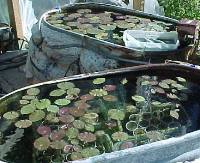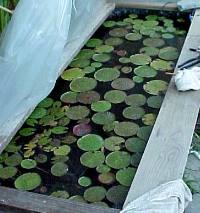Our Adventure With Victoria 2003
Click images to enlarge
We keep saying that Victoria is not an easy plant to grow and it's still true. The requirements of adult plants for light, heat and nutrients can be tricky but that's not where the main problems have been. Difficulty of germination of seeds has been solved with fresher seeds, better storage and, above all, "nicking" hard-to-start lots. The BIG problem has been getting seedlings from sprouts to teenagers.
|
Over the years, growers have been faced with "melt", "burn", failure to thrive and many other maladies peculiar to Victoria. Our personal survival rate was less than 1% of seedlings healthy enough to plant. On rare occasions a particular individual would show us what seedling growth could and should look like, making our general failure all the more frustrating. Continual experimentation, by us and by others interested in Victoria, has gradually shown us the absolute essentials. Without EACH and EVERY ONE of these aspects attended to properly, success with seedlings will be sheer luck.
The final ABSOLUTE essential is peat, a small layer in the bottom of the cups or pots. We don't know why it works but we know without question that it does. We know that peat acts as an acidifier, though this may not be a factor in some soils. We speculate that it somehow acts as a buffer. It's also possible that peat retains some of the antibiotic properties attributed to sphagnum moss, peat's geologic predecessor. Regardless, in combination with the other essentials above, it has brought our survival rate to 80% of seedlings planted at the proper time (with hastate leaves and roots but not left in the bags too long). We have tried mixing peat through our soil (sand) rather than putting it on the bottom of the cups. Mixing it tends to blacken the hastate leaves. Some seedlings survive this but at a far lower rate than for those with peat at the bottom. We have also tried several humate products in place of the peat and none work as well. As mentioned in other articles, we credit Craig Presnell with the peat piece of the puzzle. For many years, he has used it with great success for his waterlilies and decided to try it with Victoria seedlings in the winter of 2003. The proof was clearly visible in his results compared with ours. We adopted it and now have wonderful results ourselves. In discussion with Craig, we also found we agree on the necessity of using the cocktail to feed seedlings. Some growers think it's too complicated to bother with and lose their seedlings. Others go to the trouble and their seedlings survive if the other conditions are met. We don't want to be dogmatic but we do want to pass on what our combined experience is telling us. See Roots Again. |
temperature averages January 2004 |
 Tank 1 - 86-87F Tank 2 - 81-82F |
|
 Tank 3 - 68-78F |
|
 Tank 5 - 62-80F |
|
 'Adventures' in Tank 4 Average 62-72F |
Duneside Tank 4 is 4' x 16' x 16" and heated with two 150W submersible aquarium heaters.